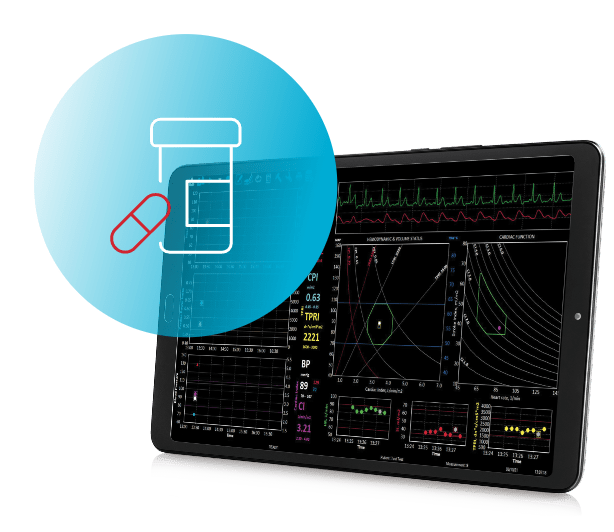Pharma Clinical Trials
NICaS Can Help You To:
- Assess inclusion criteria
- Obtain real-time dose titration information
- Monitor cardiac safety in both cardiovascular and non-cardiovascular trials
- Evaluate drug efficacy and safety
- Support single- or multi-site clinical trials
- Document desired and adverse effects of candidate compounds
- Reduce total trial time by facilitating patient recruitment
- Decrease time-to-market of successful compounds
NICaS unique technology:
Allows easy application with only two sensors
Secures the data transfer to the core lab
Accurately assesses the smallest hemodynamic changes

- Paredes OL, Shite J, Shinke T, et al. Impedance cardiography for cardiac output estimation: reliability of wrist-to-ankle electrode configuration. Circ J. 2006;70(9):1164-1168. doi:10.1253/circj.70.1164
- Cotter G, Schachner A, Sasson L, Dekel H, Moshkovitz Y. Impedance cardiography revisited. Physiol Meas. 2006;27(9):817-827. doi:10.1088/0967-3334/27/9/005
- Cotter G, Moshkovitz Y, Kaluski E, et al. Accurate, noninvasive continuous monitoring of cardiac output by whole-body electrical bioimpedance. Chest. 2004;125(4):1431-1440. doi:10.1378/chest.125.4.1431
- Tita C, Gilbert EM, Van Bakel AB, et al. A Phase 2a dose-escalation study of the safety, tolerability, pharmacokinetics, and haemodynamic effects of BMS-986231 in hospitalized patients with heart failure with reduced ejection fraction. Eur J Heart Fail. 2017;19(10):1321-1332. doi:10.1002/ejhf.897
Related Clinical Markets
Related Clinical Studies
Utility of NICaS Non-Invasive Hemodynamic Monitoring in Critically Ill Patients with COVID-19
Authors: Wisam Zabeeda, Jonah Benjamin Cohen, Anat Reiner Benaim, Shiri Zarour, Yael Lichter, Idit Matot, Or Goren Conclusion: Non-invasive hemodynamic monitoring via the NICaS device
The Impact of Positive Inotropic Therapy on Hemodynamics and Organ Function in Acute Heart Failure: A Differentiated View
Authors: Juan Cheko, Nikolaos Patsalis, Julian Kreutz, Dimitar Divchev, Georgios Chatzis, Bernhard Schieffer, Birgit Markus Conclusion: Patients with acute decompensated HF benefit from positive inotropic
Comparing elective and emergency caesarean section by using bioimpedance method
Authors: Zuhal Çavuş, Ayşe Vahapoğlu, Ülkü Aygen Türkmen, Fatma Ketenci Gencer, Elif Yıldız Conclusion: Understanding normal hemodynamic values before, during, and after C/S is feasible
Noninvasive Hemodynamic Evaluation Following TAVI for Severe Aortic Stenosis
Authors: Tzlil Grinberg, Yaron Aviv, Mordehay Vaturi, Leor Perl, Maya Wiessman, Hanna Vaknin-Assa, Pablo Codner, Yaron Shapira, Ran Kornowski, Katia Orvin Conclusion: Unique short‐term adaptive
Correlation of Impedance Cardiography-Derived and Cardiac Magnetic Resonance-Derived Stroke Volumes
Authors: Pedram Hassan-Tash, Umar Ismail, Iain D C Kirkpatrick, Amir Ravandi, Davinder S Jassal, Brett Hiebert, Malek Kass, Richard A Krasuski, Ashish H Shah Conclusion:
Non-invasive hemodynamic profiling of patients undergoing hemodialysis-a multicenter observational cohort study
Authors: Keren Doenyas-Barak, Marcia H. F. G. de Abreu, Lucas E. Borges, David Pereg, Ilya Litovchik, Shmuel Fuchs and Sa’ar Minha Conclusion: Non-invasive assessment of
